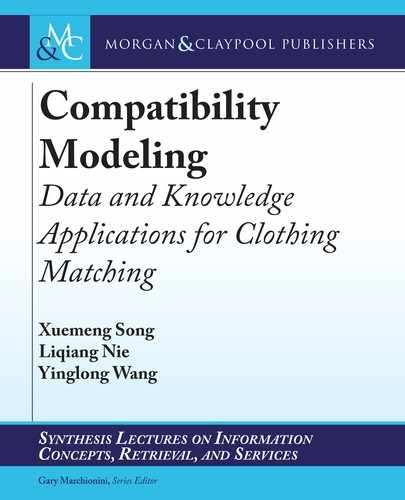66 6. PERSONALIZED COMPATIBILITY MODELING
domain [34, 43, 110] mainly utilized the MF framework to model user preferences based on
their feedback with real-world datasets. For example, Hu et al. [43] proposed a functional ten-
sor factorization model aiming to tackle the problem of personalized outfit recommendation
based on a dataset comprising of 150 users. Although this method is effective in the whole out-
fit recommendation, the cold start problem constitutes a remaining issue that worths further
exploring. Toward this end, He et al. [34] introduced a scalable matrix factorization model that
incorporates the visual signal of items into the user preference predictors to fulfill the recom-
mendation task. In a sense, existing efforts focus on exploring the latent user-item interactions
to tackle the personalized recommendation problems. Beyond that, in this work, we aim to fulfill
the task of personalized clothing matching, where both the user-item preference and item-item
compatibility need to be well explored.
6.3 METHODOLOGY
In this section, we first give the research problem formulation and then detail the proposed
personalized compatibility modeling scheme, GP-BPR.
6.3.1 PROBLEM FORMULATION
Suppose we have a set of users U D fu
1
; u
2
; : : : ; u
M
g, a set of tops T D ft
1
; t
2
; : : : ; t
N
t
g, and a
set of bottoms B D fb
1
; b
2
; : : : ; b
N
b
g, where M , N
t
, and N
b
denote the total numbers of users,
tops, and bottoms, respectively. Each user u
m
is associated with a set of historically composed
top-bottom pairs O
m
D f.t
i
m
1
; b
j
m
1
/; .t
i
m
2
; b
j
m
2
/; : : : ; .t
i
m
N
m
; b
j
m
N
m
/g, where i
m
k
2 Œ1; 2; : : : ; N
t
and
j
m
k
2 Œ1; 2; : : : ; N
b
refer to the index of the top and bottom. For each t
i
(b
i
), we use v
t
i
(v
b
i
)
2 R
D
v
and c
t
i
(c
b
i
) 2 R
D
c
to represent its visual and contextual embeddings, respectively. D
v
and D
c
denote the dimensions of the corresponding embeddings.
As a matter of fact, different people may have different fashion tastes and thus prefer
different clothing items to make favorable outfits. Accordingly, in this work, we aim to tackle
the essential compatibility modeling between fashion items for clothing matching by taking
the user factor into account. Without loss of generality, we particularly investigate the problem
of “which bottom would be preferred by the user to match the given top.” Let p
m
ij
denote the
preference of the user u
m
toward the bottom b
j
for top t
i
, based on which we can generate a
personalized ranking list of bottoms b
j
’s for a given top t
i
and hence solve the practical problem
of personalized clothing matching. In particular, to accurately measure p
m
ij
, we focus on devis-
ing a personalized compatibility modeling network F , which is capable of compiling the user
preference context into the compatibility modeling between fashion items as follows:
p
m
ij
D F
t
i
; b
j
; u
m
j‚
F
; (6.1)
where ‚
F
refers to the to-be-learned model parameters.
In a sense, toward personalized clothing matching (e.g., matching a bottom for a user’s
top), it is natural to incorporate both the item-item compatibility and the user-item preference.
..................Content has been hidden....................
You can't read the all page of ebook, please click here login for view all page.
